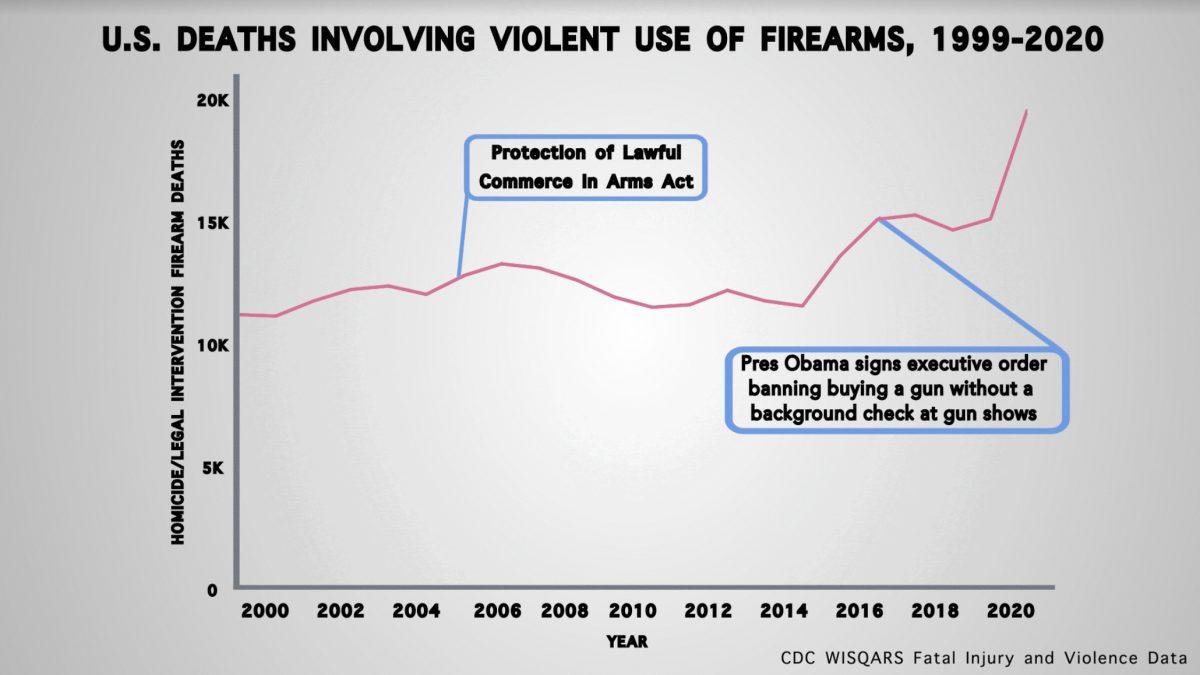

Ezra Bitterman is a freshman journalism major at MU. He is an opinion columnist who writes about elections and societal observations for The Maneater.
“Kind, polite, thoughtful”; that’s what Olivia King was known for. She died in the Collierville grocery store shooting last month.
A pandemic, racial upheaval and a contentious election define the past 18 months. For many — including myself — gun violence fell out of view. In the chaos, stories like Olivia King’s were not told, allowing for what was already a plague on our society to reach a boiling point. The gun control debate needs to be proactive and consistent so we can get ahead of the next act of senseless violence.
2020 was the worst year for gun violence in over two decades. Guns killed almost 20,000 people. Part of the problem is the outsized impact of mass shootings, which are not easily defined. For example, Mother Jones claimed there were ten mass shootings in 2019, while the Gun Violence Archive claimed there were 418. Mother Jones narrows mass shootings to events in public with three fatalities not affiliated with domestic or gang violence. In contrast, the Gun Violence Archive defines any shooting with four people fatally or non-fatally injured. Vague definitions surrounding shootings provide the public with a confusing narrative. But it shouldn’t matter; 20,000 deaths are 20,000 lives lost.
Public mass shootings play a disproportionate role in how we view gun deaths. So far in 2021, less than one percent of gun deaths are from mass shootings, yet they receive almost all of the attention. This makes gun control a very streaky issue. A major shooting happens: thoughts and prayers are given, national politicians talk about it and then it goes away until the next attack.
While it’s shown that mass shootings do motivate gun policy on the state level, having such inconsistent discourse on the issue doesn’t allow for consistent pressure on lawmakers, or for the nation to see the bigger picture. In comparison, health care — a consistent top-three issue in terms of voting decisions — is talked about consistently. Health care stays at the center of the national consciousness, is consistently talked about in debates and discussed in the national media and among the public.
Whereas a few horrific mass murders define the gun control debate, the ones using guns to kill themselves or their family are often overlooked; this creates a confusing narrative on what it means to be safe in America. As the pandemic forced lockdowns, there weren’t large public shootings to focus the public on gun control. It wasn’t even discussed in the 2020 presidential debates, and was a middle-of-the-pack issue among voters even as record-high gun deaths enveloped the nation.
In 2012, President Barack Obama stood defeated. The senate had once again failed to pass a bill mandating more extensive background checks — an idea supported by 90% of Americans — after the Sandy Hook elementary shooting.
The bill was built on moderation drafted with bipartisanship, yet it still failed. The National Rifle Association ran defamatory ads on the bill calling Obama an “elitist hypocrite.” Only six Republicans in Congress don’t take money from the NRA, as the organization outflanks anti-gun pacs 14 times over in terms of campaign donations.
The pro-gun lobby has such a strong grip on the national conversation that even modest federal gun control legislation is laborious to pass. Obama would later call failure to pass gun control legislation the “greatest frustration of his presidency.”
Currently, gun control within the states is a different story. According to a report done by Harvard Business School, following mass shootings, 15% more gun-related bills are brought to state legislators. Even further, larger mass shootings correlate to more gun policy. Whereas industrial shootings have little to no effect. Harvard Business determined that it takes 125 individual gun deaths to have the same impact as one death in a mass shooting.
Gun violence causes an immense amount of pain to those afflicted and fosters a national consciousness of fear. The path we’re on is unsustainable as firearm risk continues to increase. To effectively limit gun violence, a consistent, proactive discussion is necessary.
The Maneater encourages you to donate to The Brady Plan which is committed to bringing comprehensive gun control reform to Congress.
Edited by Cayli Yanagida | [email protected]